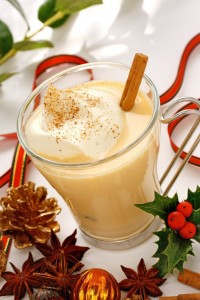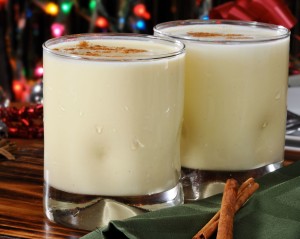Perhaps no other drink is as closely associated with the holidays as eggnog. Beloved for several centuries, eggnog as a drink has stayed relatively the same over the years. The ingredients are simple: eggs, cream or milk, spices (especially nutmeg), sugar, and alcohol. However, this seemingly basic drink has a long and somewhat storied history.
Eggnog became a popular drink in England and the Colonies near the end of the 18th century. Originating in England, it is believed to have begun as a derivation of a drink called posset, which was a hot drink made with eggs, milk, and ale or wine. Eggnog became a favorite among the English aristocracy, who were the only group that had regular access to milk and eggs in England at the time. The English preferred their eggnog mixed with Sherry or Madeira.
In America, where food was more available, eggnog became a standard drink. As the American colonists had easy access to rum, it became the standard mixer for eggnog. This led to the nickname of “grog” which was a term that would be applied to rum based drinks of many types, but came to regularly refer to eggnog.
Once the Revolutionary War began, rum was more difficult to obtain. As a response, whiskey became the main alcoholic mixer for egg nog. Once the war ended, a wider variety of alcohols were enjoyed. George Washington’s recipe called not only for rum, but also for rye and sherry.
The Egg Nog Riots: On an infamous Christmas Eve in 1826, ten West Point cadets smuggled eggs, milk, nutmeg, and two gallons of whiskey into their dormitory. This was despite (or, perhaps, because of) the strict anti-alcohol polices of the academy. Led by future Confederate president Jefferson Davis, the cadets threw themselves an egg nog party.
As with most college parties, things soon got out of hand, and the revelers drew the attention of a teacher, Captain Ethan Allen Hitchcock. Just as he arrived, Davis realized the trouble coming and shouted. “Put away the grog boys, Old Hitch is coming!” Hitchcock attempted to end the party and return the cadets to their rooms. The students rioted in response and the event led to the “Eggnog Riot” or “Grog Mutiny” which resulted in the largest expulsion of cadets in West Point’s history.
So this season, raise your whiskey and egg nog in celebration for the holidays, a new year, and the nineteen cadets who were expelled 187 years ago as a result of our favorite seasonal beverage.
References/for further reading:
- “The Egg Nog Riot” Michelle Legro, Lapham’s Quarterly
- “The History of Eggnog” by Nanna Rognvaldardottir
- Click here for the Maker’s Mark Recipe for Eggnog.
- The Egg Nog Riots via Mental Floss
Click here to return to the SWE Website.


Your article mentions ten cadets first and at the end 12. Wikipedia, though, talks about as many as 70 cadets involved. Which one is true, and where could I get more info on that?
Actually our post states that ten cadets snuck the egg nog into the dorm, and and the end of the event 19 were punished…so it seems obvious that the party grew (as college parties tend to do) beyond the original instigators as the evening wore on. The links provided offer more information on this historic event.